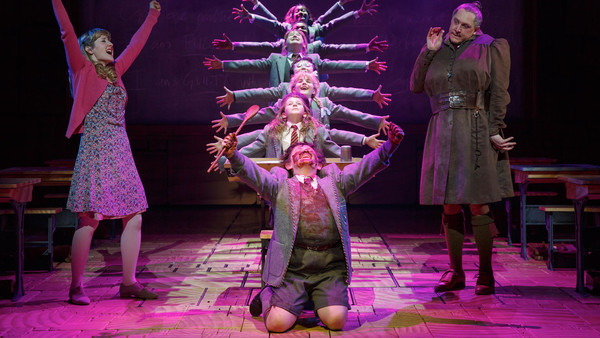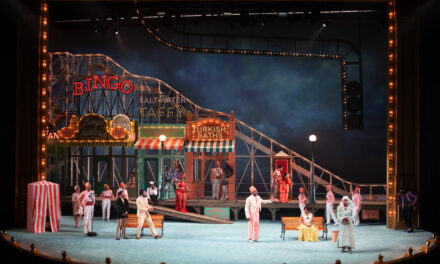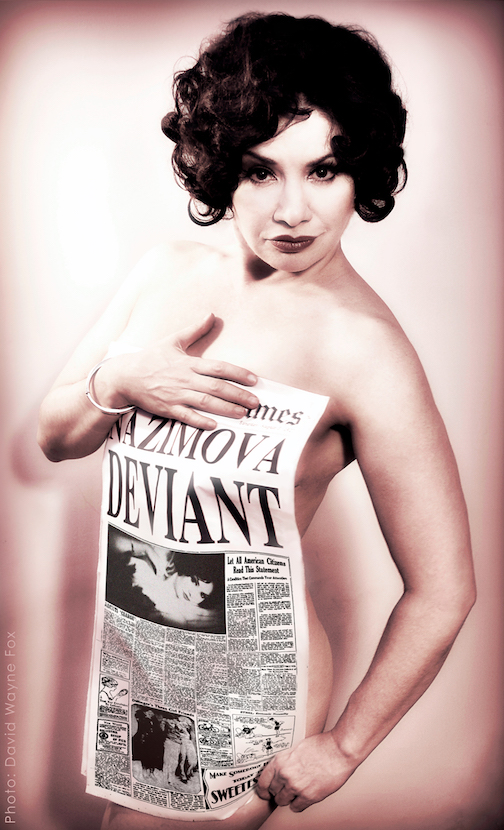by Samuel L. Leiter
During the early 1950s, Yukio Mishima (1925-1970), one of twentieth-century Japan’s greatest and most unusual writers, wrote many original plays for both the modern and traditional theatre; he even combined these interests by writing nine modern noh plays.
Noh, a leisurely, austere, hieratic form dating back to the 14th century, is staged in gorgeous costumes on a bare, wooden stage, its few scenic props simple abstractions of what they represent, with select characters wearing exquisite masks. The plays’ poetic dialogue, often concerned with Buddhist themes, is spoken in ritualistic, chanted tones. Onstage musicians and a chorus accompany the action and most plays have an extended dance sequence. Although there are now women noh artists, noh is generally performed by all-male casts.
Unlike their originals, Mishima’s noh plays are set among modern people in contemporary locales; they emphasize psychological states of mind to which contemporary audiences can respond. Of the five noh plays he adapted, Hanjo, given three performances last week at the Japan Society, is the most radically different from its original.
For several reasons, that original, by Zeami, is one of the most uncommon noh plays, most especially because it has a romantic plot that introduces the heroine’s lover, a role that in any other play hinting at a love affair would normally have been played by a child to deemphasize the erotic theme; in Hanjo the role appears to have been intended for a mature actor.
In Zeami’s play, the proprietress of an inn is upset because one of the girls in her employ who entertain travelers fell in love with one such man, Yoshida no Shōshō, with whom she exchanged fans. The proprietor, unhappy that Hanago, longing for Yoshida, has refused to wait on any subsequent guests, asks her to leave. Yoshida, returning, is disappointed to find Hanago gone. Back in the capital, he encounters a mad woman who dances. Seeing her fan, he realizes her identity. Hanago recovers, the pair is reunited, and the play ends happily, rare for a noh play.
Mishima’s three-character version imagines Hanako as living with a 40-year-old spinster, an artist named Jitsuko Honda, in the latter’s studio. We learn from Jitsuko that Hanako is a beautiful, mad girl who waits daily at the train station for the lover with whom she exchanged fans, and who is unlikely ever to return. Jitsuko fears that the man, Yoshio, may read a just-published newspaper article about Hanako, and come seeking her. This would mean Jitsuko’s losing her. When Yoshio does arrive, however, Hanako remains mad and fails to recognize him. Thus, unlike the original, the play ends unhappily.
Hanjo was created and performed by the ensemble company called SITI. Company co-director Leon Ingulsrud, raised in Japan, directed it from his own translation although Donald Keene’s version is readily available.
Ingulsrud’s production, unlike somewhat more realistic stagings of the play, seeks the ascetic feel of a noh play, using only a shiny floor backed by a black wall, designed and starkly lit by Brian H. Scott. Scenic props consist merely of several black chairs put solemnly in their places by the performers at the play’s beginning. Mariko Ohigashi’s unassuming costumes of black pants and white tops for everyone, with a black jacket for one man and a vest for the other, avoid anything specifically Japanese; the actors are all barefoot.
In a questionable casting decision, two men ( Gian-Murray Gianino and Stephen Duff-Webber) and a woman (Akiko Aizawa ) act the play’s two women and a man. A violinist, Christian Frederickson, sits on the border of the acting area where he accompanies the action with moody music. Although not specifically indicated in the script, Hanako, using a transparent, plastic fan, does a Japanese-style dance, choreographed by Wendell Beavers.
Ingulsrud’s measured pacing and the actors’ carefully controlled blocking and gestures all contribute to a lyrical, poetic tone that skillfully reflects noh’s otherworldly ambience, even if that’s not what Mishima himself intended. But the production, seeking to investigate issues of role-playing, gender, and identity, goes even further, making several significant but dubious choices.
Briefly, the play is done three times, stretching its half-hour length to 90 minutes. For each round, the actors switch roles so that everyone gets to play three parts. Moreover, Aizawa plays all her roles in Japanese while her partners act in English. If you don’t know Japanese, you have to wait until the second play to find out what she said in the first. And you’ll have to remember the first performance to follow what she’s saying in the second. No information about any of this is given in the program so—as I later discovered—some people left thinking Mishima wrote the play this way.
I’m unconvinced that any of these distracting innovations is necessary or of great value in realizing the play’s dramatic values. What they best reveal, in fact, is how perfectly suited Akiko Aizawa is to the material, which she makes bitingly real both in her vocal attack and dancer-like grace.
Gianino and Webber are fine actors but they seem awkwardly out of place—especially when playing delicate women—within the dynamic of authentic emotion and physical expressivity that Aizawa brings to the table. In fact, having her speak in Japanese with such conviction also serves to make even Ingulsrud’s otherwise perfectly acceptable translation sound flat.
Given their relative brevity, I’d have preferred to see three Mishima noh plays rather than one Mishima noh play three times.
Hanjo. Closed. Played at Japan Society (333 E. 47th Street, between First and Second Avenues). www.japansociety.org
Photos: Julie Lemberger
























